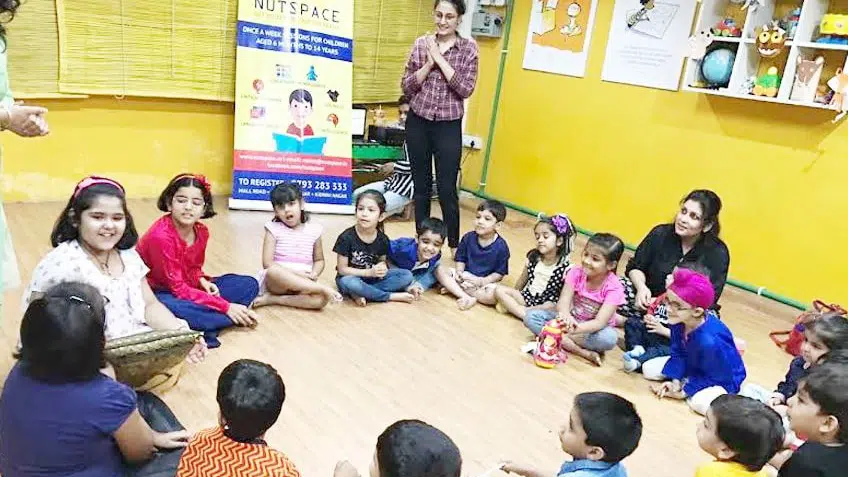Storytelling is the most important form of communication. There are stories everywhere. Our brains are hard-wired to think and express in terms of a beginning, middle and end. Stories are highly effective because the brain processes the imagination the same way as reality. Storytelling can help create a multi-disciplinary classroom.
Picture this:
A bubbly 5-year-old Tina with a grumpy expression goes to her mom and says, ‘I am Venus and no one can mess with me. I have a very hot temper.’ Tina then stomps her feet on the floor angrily.
‘So what did you learn today Tina?’, asks her mother affectionately
‘Venus is the hottest planet in the solar system.’, pat comes the answer
‘But isn’t Mercury the hottest since it is closest to the sun?’, quizzes her mother
‘Boo hoo hoo! I am Mercury and I am also small just like Pluto but at least Pluto has moons, I have none! Boo hoo hoo.’, Tina pretends to cry
‘And no mommy, Venus is hot because it traps the heat of the Sun and believe me mommy Mercury has its own issues.’, Saying that Tina runs out to play with her friends.
Tina’s mother is mighty proud. She then looks enthusiastically at the story her child has heard at the NutSpace class today. ‘I am definitely doing something right’, she smiles as she plays ’A message for Pluto’
Here is the Story on the Solar System:
The brain is hard-wired for stories
Imagine walking into a Science class and coming back with drama, role-play and voice modulation. Visualize learning mathematical concepts by baking. Think about learning being fun and lifelong. Imagine learning anything and everything through stories.
What is education?
Education is the process of facilitating learning, or the acquisition of knowledge, skills, values, beliefs, and habits. Education plays an important role in shaping an individual’s life. If an early learner is subjected to duress in order to get educated the process will lose its essence. Never forget that education is meant to elevate the mind not burden it.
What is a multi-disciplinary classroom?
A multi-disciplinary class environment not just provides a child with subject knowledge but also makes learning an exciting part of growing up years. This environment ensures that studies, school, and learning are embraced by children early on in life and not feared. The first five years of a child’s life are fundamentally important. Early experiences in a child’s life play an important role in shaping the brain’s architecture and provide a base for brain’s functioning throughout life.
Children learn more quickly during their early years than at any other time in life. They need to be provided with a constructive and holistic learning environment where their curiosity is fed not just by way of knowledge but positive experiences too.
6 Ways Early Learning Coaches/teachers and parents can make learning multi-disciplinary:
- Make learning fun. Introduce Circle Time in your classroom/study routine. Use this time to help a child get comfortable in class. Talk to them about what they like to do, what they ate that afternoon or simply their favourite colour. This works wonders to help children break the ice, open up and tackle anxiety just before a big day/session.
- Use Storytelling in the classroom: Rudyard Kipling said, ‘If History were taught in the form of stories, it would never be forgotten.’ Our brain is hardwired for stories. Children don’t need information. They are up to their eyeballs with information. What they need are stories:
- Stories to help them understand, make sense and have faith.
- Use stories to teach all subjects.
- Stories make the lesson easy to understand and retain.
- All children have different learning styles and abilities – stories resonate with each style of learning.
- Sequencing: As opposed to watching animated content that may be passive, stories are active. When the mind hears a story it creates visuals. This is a wonderful way of recalling and shaping those visuals. Talk to the children about what happened at the beginning of the story to the middle and finally the end. Talk about all the ups and downs, highs and lows of the story. Carefully reiterating the important and hard bits. You may even make a Storyboard to reinforce the lesson further.
- Use Role Play and Drama in the classroom: Humans love drama. When we enact something it resonates with us at a deeper subconscious level. Not only does it make learning permanent it also helps enhance confidence and communication skills.
- Throw in a creative activity: This is probably something most children love. They love to create. Ensure your lesson includes an art and craft activity in theme with the topic of the day. Let them get their hands dirty. Let them use their fine motor skills and imagination to create something from the story.
- Don’t judge: Remember all children have different learning styles and abilities. As educators, our responsibility is to cater to each little mind engaging with us.
So just spin stories and sprinkle the magic dust!

